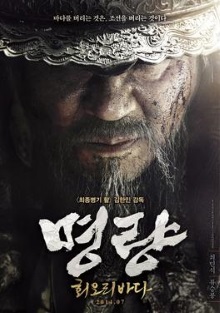
The box office statistics for this South Korean historical epic are really something to behold. It sold more than 17 million movie tickets, out of a population of approximately 50 million people. Outside of its home country, it did respectable, but not spectacular, sales. Sure, it’s a nationalistic puff piece, but these numbers suggest that The Admiral might be a film worth watching if only for the novelty of a South Korean mega-blockbuster.
Set in the late 16th century, this movie extols the heroics of admiral Yi Sun-sin. You get to know this name very well because his enemies make a habit out of shouting it. In what appears to be South Korea’s version of the Battle of Thermopylae, he leads a tiny flotilla of barely a dozen ships against Japan’s invasion force of over 300 vessels. Plus, since legends of great heroes are always forged out of great adversity, he has to do it in the face of suspicion from his own ruler, doubts about his ability from the land-based army and the fear of his troops who all believe that the odds look hopeless.
Director Kim Han-min uses the first hour or so of the movie to set up the historical context surrounding the impending clash. Unfortunately, despite Choi Min-sik’s considerable acting ability as the titular admiral, the expository scenes lack energy and tension. Some melodrama is always to be expected in movies that are purpose made to rouse the national spirit but it doesn’t mean that they should be forgiven. In this case, the director is ham-fisted in playing up the opposition and trying to create dramatic moments, resulting in scenes that drag and feel too heavy. They don’t even convey enough information to international audiences. While I’m sure Korean audiences know exactly what a turtle ship is, I sure didn’t.
Things pick once the fighting starts and the happy news is that the rest of the movie is pretty much one long naval battle. Predictably, the wide shot of the massive Japanese armada is pure CG and it shows. Apart from this however the production values are superb with fantastic attention to detail, right down to the rivets on the soldiers’ armor and hairline cracks on the wooden planks. There’s every kind of fighting you can imagine, from long-ranged cannon bombardments, to massed volleys of fire with rifles and bows and melee combat during boarding actions. They even worked in a sniper duel! Then throw in strong currents and whirlpools for added peril.
It’s exciting, fast-paced and while the eventual victor is never in doubt, the movie throws enough danger at the admiral’s flagship that the threat feels real. Still, the incredible durability of the ship given how much punishment it suffers does strain your suspension of disbelief after all. I was also disappointed that after making an impressive entrance, the pirate-king Kurushima Michifusa who leads the Japanese offensive turns out to be all bluster.
On a more personal note, the strategy gamer in me was genuinely curious about how exactly a dozen ship can win out against such odds. It turns out that Korean ships pack cannons while the Japanese ones don’t. The Japanese historically rely mostly on boarding actions and have only archers to provide ranged attacks (I should know, I played Shogun 2!) As a gamer, I think I would pick a dozen ships with cannons over a hundred ships without them so long as I can control the engagement range. Apparently the turtle ship is an optimized cannon-firing ship with armor that is proof against archers and has features to deter boarders. No wonder the Japanese feared them so much!
As expected, The Admiral is no more and no less than South Korea’s version of the Hollywood summer action blockbuster. After getting past the slow start, it offers as good a spectacle as any Hollywood movie with the added novelty that it’s based on Korean history.